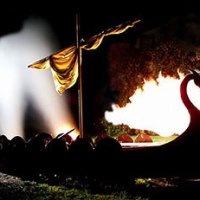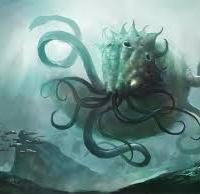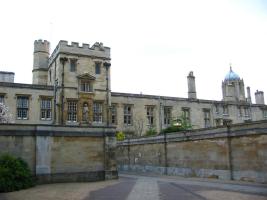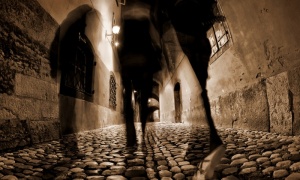I have been haunted by the writings of M R James since childhood but when asked what is my favourite of all his ghostly tales I’ve never fully been able to answer. Lost Hearts, an early tale which apparently James didn’t much care for, and which only appeared in Ghost Stories of an Antiquary to fill up the collection at the request of his publisher, does however retain a special corner in my affections. This was my first introduction to James and ever since I have always been surprised at the author’s seeming negative attitude to this particular story, which remains one of the classic short chillers in whatever guise it has assumed, on the page or on the screen. The plot is well known. Abney, an elderly scholar, reclusive and of independent means, invites his young cousin Stephen, recently orphaned, to live with him. His secret intention is to kill the boy in order to obtain his heart, which he believes will give him magical powers and, possibly, immortality. Two murders have already been committed for this purpose, and the young victims’ corpses carefully concealed, but their whereabouts are frighteningly disclosed to the intended next victim, and their intrusion back into the world of the living occurs in a series of disturbing incidents that culminate in the story’s horrifying denouement.
 The setting of Aswarby Hall, a few miles south of Sleaford in Lincolnshire, was a real place and several other elements of the tale have a sound basis in fact or folklore. The villainous Abney is an expert in the religious beliefs of the later pagans, a major source of theory and practice for students of magic. He has a complete library on the Mysteries of Orpheus and the Neo-Platonist School, and the Mithraic cult statue he owns foreshadows in great detail Abney’s intentions. In the ritual it symbolised, life sprang from the spilled blood generated by the sacrificial act. The rites of Mithras were a quest for immortality and equality with the luminous gods. Devotees attained to the celestial banquet, the earthly counterpart of which was a sacramental communion compared by Tertullian and Justin Martyr to the Eucharist. The prevalent theme was triumph over death in nature and the soul. We are told that the purpose of his studies was “enlightenment of the spiritual faculties”, but this we might have surmised both from the Abney library, which must have been a fascinating one, and his choice of statuary. Abney quotes as an example of such attainments Simon Magus, an apt choice for a student of the Mysteries, for he was, in the eyes of his Syrian disciples, the founder of Gnosticism.
The setting of Aswarby Hall, a few miles south of Sleaford in Lincolnshire, was a real place and several other elements of the tale have a sound basis in fact or folklore. The villainous Abney is an expert in the religious beliefs of the later pagans, a major source of theory and practice for students of magic. He has a complete library on the Mysteries of Orpheus and the Neo-Platonist School, and the Mithraic cult statue he owns foreshadows in great detail Abney’s intentions. In the ritual it symbolised, life sprang from the spilled blood generated by the sacrificial act. The rites of Mithras were a quest for immortality and equality with the luminous gods. Devotees attained to the celestial banquet, the earthly counterpart of which was a sacramental communion compared by Tertullian and Justin Martyr to the Eucharist. The prevalent theme was triumph over death in nature and the soul. We are told that the purpose of his studies was “enlightenment of the spiritual faculties”, but this we might have surmised both from the Abney library, which must have been a fascinating one, and his choice of statuary. Abney quotes as an example of such attainments Simon Magus, an apt choice for a student of the Mysteries, for he was, in the eyes of his Syrian disciples, the founder of Gnosticism.
Abney hopes to attain these ends by human sacrifice involving eating the hearts of “not less than three human beings below the age of twenty-one years”, having found this recipe “in considerable detail in the works of Hermes Trismegistus.” ‘Thrice-great Hermes’ was the name given by the Greeks to the Egyptian god Thoth. Numerous mystical works in post-Christian times were attributed to him, and they were later used by medieval astrologers and alchemists. However, whilst the many writings attributed to this author include treatises on alchemy, the invocation of angels, and allegedly ancient philosophical wisdom, they do not include cannibalism. There was, however, a genuine Scandinavian folk belief that magic powers of flight and invisibility could be attained by eating the hearts of twelve foetuses cut from their mothers’ bodies, and James could have learnt this by reading the works of E T Kristensen, who is now regarded as one of the foremost folklorists of his age. James had also read Hermes Trismegistus as early as 1878, but it seems strange that James should blacken the reputation of the author in this way. He may simply have been indulging in mystification here, however, misdirecting the reader to the impressive Hermes Trismegistus, but actually using folklore – probably Danish, but just possibly German.
The real power of the story lies however in the idea of children as predators. Perhaps because of a deep-rooted view of children as innocent and unsullied, with a need to be cared for and protected by parental instinct, just the sound of a child’s laughter tinged with evil is totally unexpected and exposes our innermost fears. The bodies of the dead children, hidden in the remotest corners of the vast and rambling Aswarby Hall, make their dreadful presence felt soon after Stephen’s arrival, the girl appearing horribly to him in a disused bathroom, scratches materializing on his bedroom door and his night-gown, and conspiratorial whispers being overheard by Parkes the butler in the shadows of the wine cellar. Whatever the dead children’s main purpose, it is not to save the intended third victim from sharing their fate, for young Stephen becomes almost as much their prey as his guilty cousin. This is made clear in perhaps the most important and disturbing scene in the story, when Stephen discovers that one of the ghosts has visited him in his sleep and tried to claw its way to his heart. It is obvious from this that the ghosts are not to be seen as Stephen’s allies in some kind of Good versus Evil confrontation, or simply as avengers. This is what makes Lost Hearts a truly great ghost story, introducing formidable visitants of the very worst kind.
If you’d like to read Lost Hearts you can do so by visiting the ‘Ghost Stories’ section of this site or, if you’d prefer, you can watch the chilling adaptation of the story below.

















The tv adaptation is not that bad, but when I read the tale I didn’t imagine cousin Abney looking like that. And a hurdy gurdy doesn’t sound like a mandolin, holy smoke ! 😀
If you’re referring to the BBC production the sound of the hurdy-gurdy is, in fact, that of the french instrument: Epinette des Vosges. It’s related to the mountain dulcimer and nothing like a hurdy-gurdy.
Hi thanks for shaaring this